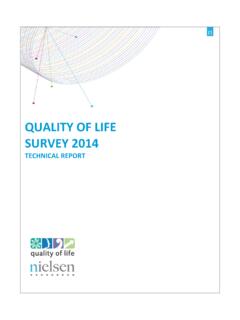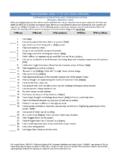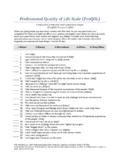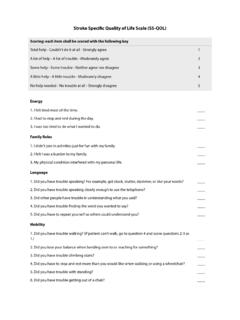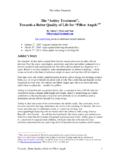Transcription of QUALITY OF LIFE SURVEY 2014
1 QUALITY OF life SURVEY 2014 CONTENTS PAGE: 1. EXECUTIVE INSIGHTS 3 2. RESEARCH DESIGN 9 3. QUALITY OF life 14 4. HEALTH AND WELLBEING 17 5. CRIME AND SAFETY 24 6. COMMUNITY, CULTURE AND SOCIAL NETWORKS 37 7. COUNCIL PROCESSES 57 8. BUILT AND NATURAL ENVIRONMENT 64 9. TRANSPORT 79 10. ECONOMIC WELLBEING 99 APPENDIX I COMPARISON WITH 2012 106 APPENDIX II SAMPLE PROFILE 121 APPENDIX III RESPONSE TO OPEN ENDED QUESTIONS 129 APPENDIX IV - QUESTIONNAIRE 132 1. EXECUTIVE INSIGHTS 4 INTRODUCTION The 2014 QUALITY of life SURVEY is a partnership between six New Zealand Councils. The SURVEY aims to measure respondents perceptions in several domains, including: QUALITY of life Health and wellbeing Crime and safety Community, culture and social networks Council decision making processes Environment Public Transport Economic Wellbeing.
2 This following report presents the results for the Six Council areas. City level reports are also available for five of the six Councils. METHODOLOGY This SURVEY was carried out using a sequential-mixed methodology. A random selection of residents (from the Six Councils) was made from the Electoral Roll and respondents were encouraged to complete the SURVEY online or via a hard copy questionnaire posted to them. Fieldwork took place between 9 June and 28 July 2014. Completed questionnaires were received from 5,295 respondents made up of 2,441 Auckland respondents, 611 Porirua respondents, 569 Hutt respondents, 647 Wellington City respondents, 488 Christchurch City respondents, and 539 Dunedin respondents.
3 Full details of the SURVEY methodology can be found in the QUALITY of life SURVEY 2014 Technical Report. 5 QUALITY OF life The majority (82%) of respondents living in the Six Council areas rate their overall QUALITY of life positively, with 20% rating it as extremely good and 62% as good. Just over a quarter (27%) of the Six Council areas respondents say their QUALITY of life has increased compared with twelve months ago. HEALTH AND WELLBEING Overall health Eight in ten (82%) of the respondents living in the Six Council areas rate their health positively, responding with a rating of either excellent (15%), very good (29%), or good (37%). Frequency of doing physical activity Just under half (46%) of the respondents living in the Six Council areas say they undertake physical activity five or more days a week.
4 Emotional wellbeing Nearly three quarters (73%) of respondents rate themselves as having a positive emotional wellbeing, with a rating of very happy (17%) or happy (56%). Satisfaction with life in general Just under three quarters (71%) of the Six Council areas respondents are satisfied or very satisfied with their life in general. Stress Almost two in ten (17%) respondents living in the Six Council areas are regularly experiencing stress that has a negative impact on them, with 2% always stressed and 15% stressed most of the time. Availability of support The majority (92%) of respondents say they have someone to turn to for help if they were faced with a serious illness or injury, or needed emotional support during a difficult time.
5 CRIME AND SAFETY Perceptions of crime and other undesirable problems Half (49%) of the respondents living in the Six Council areas view vandalism as a problem within their area over the last twelve months. Just over half (55%) view car theft or damage to cars as a problem, while nearly two thirds (64%) view dangerous driving (including drink driving and speeding) as a problem. Nearly half (45%) of the respondents living in the Six Council areas perceive the presence of unsafe people as being a problem and just over 6 half (55%) perceive alcohol or drugs to be a problem in their area over the last twelve months. A third of respondents say people begging on the street is a problem in their area.
6 Sense of safety The majority (96%) of respondents feel safe in their home during the day, with around nine in ten (89%) feeling safe in their home after dark. Six in ten (59%) respondents feel safe walking alone in their neighbourhood after dark. The majority (91%) of the respondents living in the Six Council areas feel safe in their city centre during the day, while just over four in ten (43%) feel safe in their city centre after dark. COMMUNITY, CULTURE AND SOCIAL NETWORKS Sense of community Three quarters (74%) of respondents living in the Six Council areas agree it is important to feel a sense of community with the people in their local neighbourhood. Just over half (53%) agree that they actually feel a sense of community with others in their local neighbourhood.
7 The most frequently mentioned reason for a lack of sense of community is a busy life (47%). This is followed by people in the neighbourhood don t talk with each other (43%) and a preference for socialising with family and friends instead of neighbours (40%). Social networks The most common social network respondents belong to is people from work or school (50%), followed by online network through websites such as Facebook, Twitter, online gaming communities and forums (49%). Contact with neighbourhood people Within the last 12 months, the majority (94%) of respondents living in the Six Council areas have had some positive contact with people in their neighbourhood such as a nod or saying hello; over two thirds (69%) have had positive contact with people in their neighbourhood ( a visit, or asking each other for small favours and 38% have had strong positive contact ( support or close friendship).)
8 About one in six (15%) respondents have had some negative contact with people in their neighbourhood in the last 12 months ( not getting on with them) and one in ten (10%) have had negative contact, where there is outright tension or disagreement. Feeling of isolation Just over two thirds (68%) of respondents living in the Six Council areas rarely felt isolated or lonely over the past twelve months. Trust Nearly two thirds (65%) of respondents say you can trust people, with 9% saying people can almost always be trusted and 56% saying people can usually be trusted. 7 Impact of greater cultural diversity Over half (57%) of the respondents living in the Six Council areas feel that the fact that New Zealand is becoming a home for an increasing number of people with different lifestyles and cultures from different countries makes their area a better place to live.
9 The most frequently mentioned reason for greater cultural diversity having a positive impact is people from other countries and cultures make the city more vibrant and interesting, including bringing more interesting food and restaurants (67%). The most commonly mentioned reason for greater cultural diversity having a negative impact is people from other countries and cultures don t integrate into New Zealand society (61%). Culturally rich and diverse arts scene Just under half (44%) of the respondents living in the Six Council areas agree their area / city has a culturally rich and diverse arts scene. COUNCIL DECISION MAKING PROCESSES Three in ten (30%) respondents living in the Six Council areas agree they understand the Council decision making process.
10 Just over half (54%) agree that they would like to have more say in what the Council does, while four in ten (40%) agree that they have confidence that the Council makes decisions in the best interests of their city. Four in ten (40%) also say the public has an influence on the decisions the Council makes. BUILT AND NATURAL ENVIRONMENT Pride in look and feel of city/local area Over three quarters (79%) of respondents living in the Six Council areas agree that their city/local area is a great place to live, responding with a rating of either strongly agree (27%) or agree (51%). Six in ten (60%) respondents living in the Six Council areas strongly agree or agree that they feel a sense of pride in the way their city or local area looks and feels.
